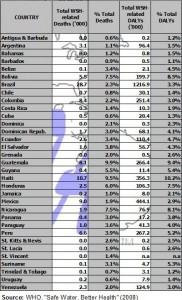« A Solid Waste Plan for Costa Rica | Home | Five LAC Nations Picked for Forest Carbon Partnership Facility »
The Disease Burden Associated with Water, Sanitation and Hygiene
By Keith R | July 22, 2008
Topics: Environmental Protection, Health Issues, Sanitation, Water Issues | No Comments »
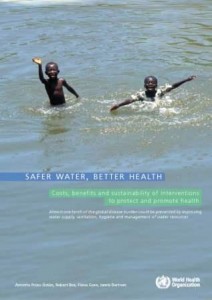 Last month the World Health Organization (WHO) released, without much fanfare, Safer Water, Better Health, its estimate of how many deaths or how much “disease burden” can be attributed to deficiencies in water, sanitation and hygiene (WSH).
Last month the World Health Organization (WHO) released, without much fanfare, Safer Water, Better Health, its estimate of how many deaths or how much “disease burden” can be attributed to deficiencies in water, sanitation and hygiene (WSH).
Access to safe drinking water and proper sanitation is key to improving health conditions in developing countries. Water-related diseases bring diarrhoeal and parasitic diseases, and lack of sanitation increases the risk of outbreaks of cholera, typhoid and dysentery. Usually it’s the poor and children most at risk from the health consequences of lack of access to proper drinking water and sanitation. This is why water and sanitation are targeted by the UN’s Millennium Development Goals.
This WHO report attempts to look at all WSH impacts on health, not just access to safe water and proper sanitation, expressed both in terms of deaths or “disease burden.” “Disease burden” is expressed by WHO in terms of “disability-adjusted life years” (DALYs), a weighted measure of deaths and disability. I’ve discussed WHO’s use of DALYs here before on The Temas Blog, primarily in reference to environmental management (here and here).
But I’ve also discussed how the World Bank has used DALYs to analyze what it and nations need to do to address chronic non-communicable disease.
Which leads to a key point: what happens to these disease burden estimates once they are available. National governments, with help from WHO, the Bank and others, will be doing their own calculations of cost-benefit of various types of interventions to improve conditions, and allocating their budgets and aid requests accordingly. Hence, these estimates should not be regarded as just academic exercises done for their own sakes.
Overview of What the Report Says
The report finds that, globally speaking, improving water, sanitation and hygiene could prevent at least 9.1% of all DALYs or 6.3% of all deaths. DALYs for children up to age 14, particularly those in developing nations (such as in Latin America and the Caribbean – LAC) linked to WSH can be as high as 20%.
What does WHO include in its calculations of disease burden related to WSH?
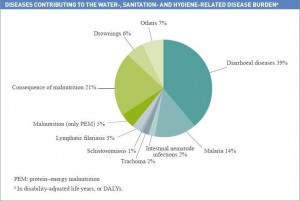 88% of the diarrhea cases worldwide for one, whether from unsafe drinking water, unclean hands or contaminated food. Also included are intestinal nematode infections (ascariasis, trichuriasis and hookworm), lymphatic filariasis, trachoma, schistosomiasis, and certain percentages of malaria, dengue, Japanese encephalitis and onchocerciasis (“River blindness”).
88% of the diarrhea cases worldwide for one, whether from unsafe drinking water, unclean hands or contaminated food. Also included are intestinal nematode infections (ascariasis, trichuriasis and hookworm), lymphatic filariasis, trachoma, schistosomiasis, and certain percentages of malaria, dengue, Japanese encephalitis and onchocerciasis (“River blindness”).
Two more areas included in the calculations that I have difficulty understanding the rational for are malnutrition and drownings.
The first I am a bit uncomfortable with because they “estimate” (sounds more like a guess, based on literature survey and “expert opinion”) that around half of all underweight and malnutrition in children can be attributed to diarrhea or intestinal nematode infections as a result of unsafe water, inadequate sanitation or insufficient hygiene.
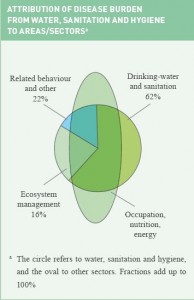 While I agree that some of this might be attributable, I wonder about the confidence level we can have in the order of magnitude picked, and what, if any, overlap there might be between this indirect measure and the DALYs and deaths already attributed to diarrhea and intestinal nematode infections.
While I agree that some of this might be attributable, I wonder about the confidence level we can have in the order of magnitude picked, and what, if any, overlap there might be between this indirect measure and the DALYs and deaths already attributed to diarrhea and intestinal nematode infections.
This is not a minor consideration — fully 26% of the WHO global figures are linked to malnutrition. For some countries in LAC, malnutrition accounts for much or even all of the deaths or DALYs attributed to DALYs.
As for drownings, I just wonder about grouping this with “disease burden” associated with the provision of safe water and adequate sanitation. Aren’t most drownings more a safety issue? Again, this is not a small quibble — 6% of WHO’s global figures are linked to drownings.
For its part, WHO says that the global figures may even be underestimates. Some globally significant diseases were omitted from the calculations because WHO could not yet decide what percentage of the DALYs and deaths to attribute to WSH. These include legionellosis, leptospirosis, conjunctivitis and otitis (inflammation of the middle ear). Also not included for the same reason are injuries related to recreational water use, and adverse impacts of exposure to certain chemicals in water, such as arsenic, fluoride, lead and nitrate.
WHO makes clear that this is still a work in progress. It plans to further investigate several factors related to WSH-related disease burden, namely:
- water hardness, lack of which has been associated with cardiovascular disease;
- fluoride in drinking water, high concentrations of which are associated with dental and skeletal impairments;
- arsenic content of drinking water, associated with various cancers;
- spinal injuries associated with recreational water use;
- legionellosis, which is associated with poorly maintained artifical water systems.
Taking a look at the figures provided for LAC nations, who do we find most affected by WSH-related disease burden? In terms of gross number of attributed annual deaths, it is Brazil at 28,700, followed by Haiti at 10,700, and Mexico at 9,000. But when expressed in terms of a percentage of total deaths in a given year for a country, it is Guatemala at 9.9%, followed by Haiti at 9.5% and Bolivia and Nicaragua tied for third at 7.5%.
As for WSH-attributed DALYs, in gross terms it is again led by Brazil at 1,216,900 DALYs, followed far behind by Mexico at 444,100 and Haiti at 356,300. But in terms of a percentage of overall DALYs, the LAC field is by far led by Haiti at 10.2%, followed by Guatemala at 9.4% and Bolivia at 8.5%.
That’s the big picture. What about specific causes?
For diarrheal disease, the largest number of annual deaths attributable to WSH are found in Brazil, at 15,000, followed by Haiti at 5,000 and Mexico at 4,500. In DALY terms, it is Brazil at 634.500, followed by Mexico at 203,900 and Haiti at 164,400.
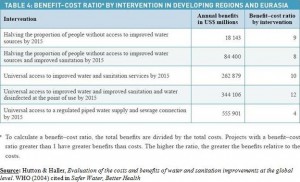 For intestinal nematode infections, the only LAC nation where deaths appear to be significant is Guatemala with 1,100. Guatemala also leads in DALYs in this segment at 46,200, followed by Brazil at 30,300 and Peru at 24,200.
For intestinal nematode infections, the only LAC nation where deaths appear to be significant is Guatemala with 1,100. Guatemala also leads in DALYs in this segment at 46,200, followed by Brazil at 30,300 and Peru at 24,200.
For schistosomiasis, a disease involving parasitic trematode flatworms, by far the country most affected is Brazil, with 900 WSH-related deaths and 63,200 DALYs. Venezuela has 7,100 DALYs in this category, and the Dominican Republic 2,400.
For trachoma, the contagious eye disease that can result in blindness, Brazil leads at 99,700 DALYs, followed by Mexico at 59,800.
What Next?
As I alluded to at the beginning of this post, many actors will now be utilizing these figures — with perhaps some fine-tuning at the national levels — to draw up cost-benefit analysis to help determine which types of interventions will bring the most benefits for the costs that developing countries can bear or get funding for.
To help this process along, WHO commissioned “a guide to understanding costs and benefits of water interventions” from consultants at the Universities of Johannesburg (South Africa), Surrey (UK) and East Anglia (UK). WHO opened the 12-chapter draft manuscript for public comment earlier this year, digested the input and is now reworking the draft with a view to publication later this year.
Tags: arsenic, ascariasis, Banco Mundial, Bolivia, Brasil, Brazil, cancer, cardiovascular disease, chemicals, chumbo, conjunctvitis, cost-benefit analysis, DALYs, dengue, diarrhoea, diarrhoeal disease, disease burden, Dominican Republic, drinking water, drowning, environment, fluoride, Guatemala, Haiti, hookworm, hygiene, intestinal nematode infections, Japanese encephalitis, lead, legionellosis, leptospirosis, malaria, malnutrition, medio ambiente, Mexico, nitrate, onchocerciasis, otitis, Peru, plomo, public health, químicos, recreational water use, República Dominicana, salud ambiental, salud pública, saneamiento, Sanitation, saude, schistosomiasis, spinal injuries, trachoma, trichuriasis, Venezuela, water hardness, Water Issues, WHO, World Bank



